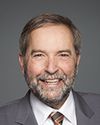Sure. First of all, I'm very pleased to be here and I'm glad I'm missed. It's always good to be missed.
A couple of comments.... Going back to Toronto, the Toronto summit of the G-20 was really the first place where this framework for a strong, sustained, balanced growth was put to the test. It's worth underlining that a great deal was achieved in Toronto. First of all, just in the lead-up to Toronto, there were a number of important announcements. The Chinese announced they were moving back to a more flexible exchange rate--certainly a positive development. We would have liked to see a little more flexibility than we've seen, but certainly a step in the right direction, and a number of other steps were taken.
It was a comprehensive agreement, including sustainable fiscal policies on the part of advanced countries, efforts and policies to boost internal demand in emerging market economies, and importantly, supported by more flexible exchange rates as well as structural adjustments that we all need to undertake to support growth. If you go back and look at the action plan, it's really quite a detailed action plan, but there is a considerable amount of work to do to implement it.
I think you want to take the steps achieved this weekend in Korea as evidence that this is moving forward. Starting to look at things like putting down specific indicators of sustainable current account imbalances is a way to implement those commitments and to make it measurable, make it real. In Toronto there were specific numerical agreements around what it meant to have sustainable fiscal policies for advanced countries. The next step now is looking at specific indicators around sustainable current account imbalances.
Certainly Canada is continuing to put a lot into this. As the governor said the other day, we need to be relentless, and I think we are looking forward to more progress.



